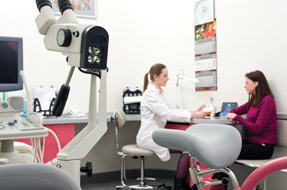1985-1994: Pharma and health care reform cause conflict
Controversies about health care policy and pharma advertisements divided College leadership.
The College was reunited physically in its eighth decade, but concurrent controversies in medicine caused some philosophical divisions.
The West Philadelphia headquarters had become too small for ACP's operations in the early 1980s, and some departments had been forced to move off-site to rented space. A number of locations were considered for a new headquarters, including Washington, D.C.; Wilmington, Del.; Bethesda, Md.; and Baltimore.
The Board of Regents eventually decided to stick closer to home, and the plan to build on Independence Mall in Philadelphia was announced at a press conference in 1986. Three years later, the current headquarters building was dedicated and opened for business.
College leaders were building a policy on access to health care during the same time. In 1990, an ACP editorial and policy paper calling for universal coverage and offering methods to provide it were published in Annals of Internal Medicine. In 1992, the College released another set of papers on the same theme, proposing “a universal health insurance system that relies on employer and publicly sponsored health insurance plans.”
Newly elected President Bill Clinton apparently liked the idea; he proposed something quite similar in 1993. But ACP and the American Medical Association (AMA) came into conflict over the concept, partly due to an error in timing.
In anticipation of a report on health care policy that the AMA was scheduled to release during its annual meeting, the College prepared “a blistering denunciation,” according to Walter J. McDonald, MD, MACP, and Alan R. Nelson, MD, MACP, writing in “Serving Our Patients and Profession: A Centennial History of the American College of Physicians (1915–2015).” “Unfortunately for ACP, the AMA had not released its report as anticipated before the College denunciation was released. There was even some question as to whether the vote had yet taken place.”
In formal protest, some of the members of the AMA House of Delegates denounced the College. More informally, a plane full of AMA meeting attendees “roundly booed” an ACP Regent as he boarded.
Things got fiery for College leadership in 1992, too, after the publication of a study in Annals of Internal Medicine finding that many pharmaceutical advertisements were misleading and lacking balance and educational value. “The pharmaceutical industry was outraged, not so much because of the publication of the research but for not being allowed the opportunity to write an accompanying editorial,” according to Drs. McDonald and Nelson.
Many of Annals' ads (which had hit a peak of 197 pages in 1992) were pulled, costing the College an estimated $1 million to $1.5 million, and the drama revealed disagreements among the College's executive vice president (EVP), the Regents, and the editors of Annals about the chain of command. Within the next 2 years, EVP John R. Ball, MD, JD, MACP, and editors Robert H. Fletcher, MD, MACP, and Suzanne W. Fletcher, MD, MACP, had all resigned.
The College was not alone in struggling with this issue. Similar conflicts around the same time at the other major journals resulted in the firing of editors.
American medicine was also still learning how to respond to the growing number of women in its ranks. Helen Smits, MD, MACP, who went on to become the first female chair of The Joint Commission, described her experience entering College leadership in the 1980s: “At my first meeting, the committee member sitting next to me, whose name I have forgotten, assumed I was a new staff member and asked me to get him a cup of coffee.”
Things were getting better, however, as the Board of Governors elected Linda Hawes Clever, MD, MACP, as its chair in 1989. This was historic both because Dr. Clever was the first female chair and because she was the first chosen by the Governors themselves instead of the Nominations Committee.
The College failed yet again to make historic progress on another front, though. In 1994, the leaders of ACP and the American Society of Internal Medicine met in Miami to discuss a merger, but they did not come to any agreement.
Medical leaders were coming to a consensus, however, on the merits of computers. ACP Online launched in the early 1990s, beginning with an electronic bulletin board for residents to share information with their peers. It was a private area on CompuServe called ResNet.
But, as much as things change, they also stay the same. In 1989, the College issued a guideline on mammography and “met a heated reaction from physicians and consumer groups,” according to Thomas John (Jock) Murray, MD, MACP.



